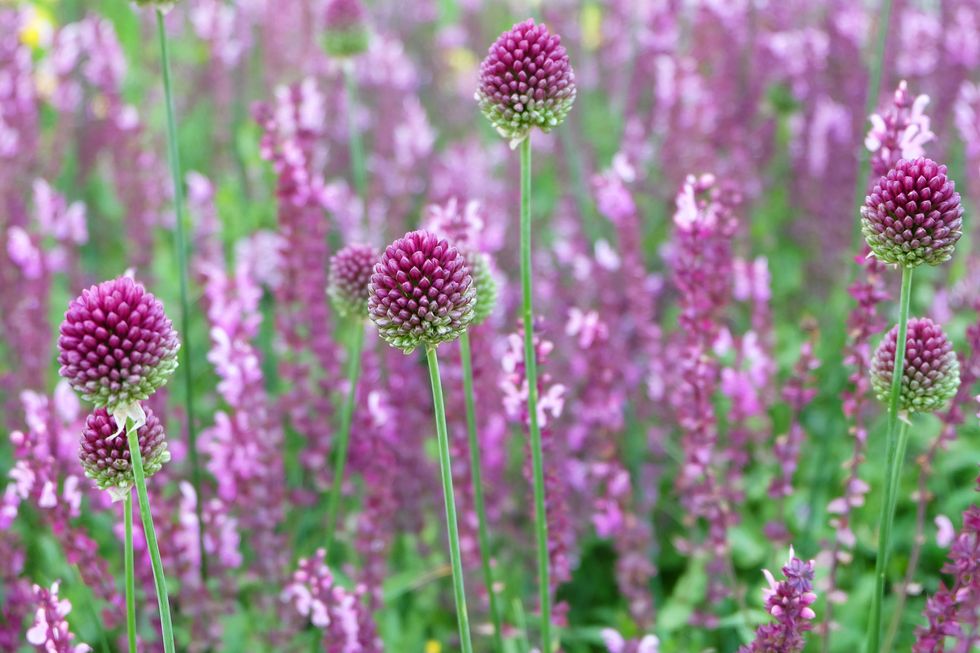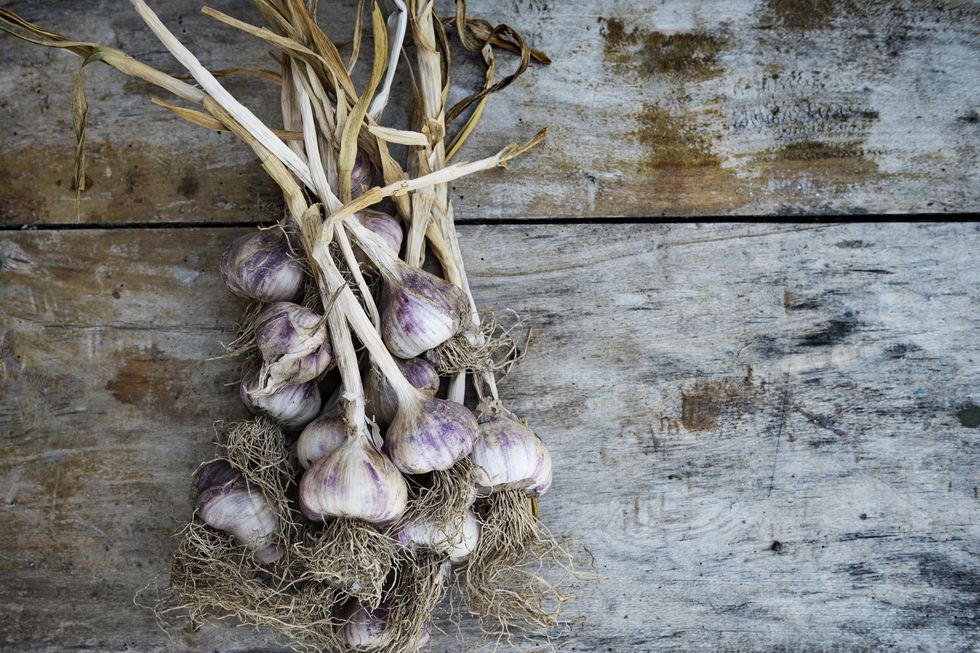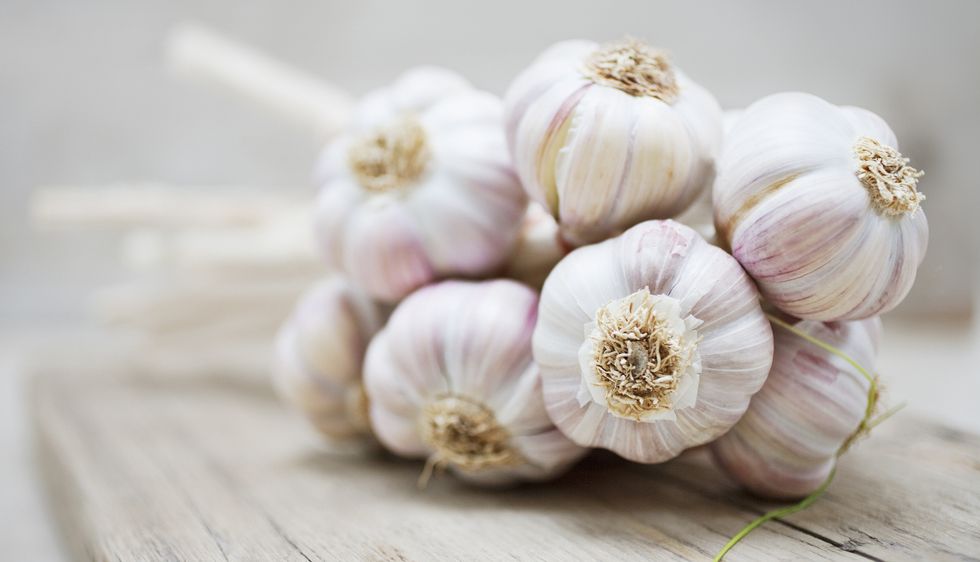As far as I'm concerned, garlic gets the blue ribbon for backyard produce. It grows easily, tastes great, and takes up little room. Even those with small gardens can raise enough to be self-sufficient in garlic for a good part of the year.
All you have to do is plant the the right varieties at the right time and in the right soil. Then harvest when the timing is right and store correctly. Here are the steps:
1. Choosing Types of Garlic
If you look in a specialist catalog, you'll find dozens of varieties, but for general purposes, the most important difference is between softneck and hardneck.
Softnecks get their name because the whole green plant dies down, leaving nothing but the bulb and flexible stems that are easy to braid. Hardnecks have a stiff stem in the center that terminates in a beautiful flower — or cluster of little bulbs — and then dries to a rigid stick that makes braiding impossible.
Softnecks, standard in grocery stores, are the easiest to grow in mild regions. They keep longer than hardnecks, but they're less hardy and produce small, strong-flavored cloves. Hardnecks do best where there's a real winter since they're more vulnerable to splitting — or simply refusing to produce — in warm climates.
Gardeners in most of the U.S. can try some of both. Specialty sellers will suggest best bets based on your climate and tastes (check out your gardening zones here). It's also wise to get some seed stock from your local farmer's' market. Whatever that garlic is, it's growing where you are.
2. Planting Garlic
Mid-fall, plant garlic bulbs in loose, fertile soil that's as weed-free as possible. Insert cloves root-side down about 8 inches apart in all directions, burying the tips about 2 inches down. Green shoots will come up; mulch around them with straw. After a hard freeze kills the shoots, draw the mulch over the whole bed.
In spring, pull the mulch back when the new shoots emerge. Give them a shot of mixed fish emulsion and liquid seaweed. Keep them weeded. Water only if the soil is dry 2 or more inches down, never pouring water into the crowns of the plants.
3. Cutting Garlic Scapes
I spent most of my gardening life cutting off the flowering scapes of hardneck garlic so they wouldn't draw energy from the bulbs. Then I read a story about a garlic growing guru who said it didn't matter a whit.
Well, it isn't really much bother. Tender young scapes are delicious and older, curly ones look wonderful in the vase. I set up an experiment, allotting 30 spaces each, in two rows, and planting the same variety in both of them. When the garlic were about half-grown, we set about cutting the scapes, but only from one row of the plants. At harvest, after trimming, we got 5 pounds of garlic out of the cut row, 6.5 pounds out of the one we left alone.
Tips for Cutting Garlic Scapes
1. There's no harm in taking a few to eat, but don't wait until they're large. Most of the scapes for sale are bigger than the 4 to 6 inches long; they should be that length for best flavor and texture.
2. You can cut some for a vase too, but don't take them too soon. If you wait until the tops are well-developed, you might get a head of tiny garlic grains that can be used whole and unpeeled in place of minced garlic. Or you'll find a clump of small round bulbs, called topsets, that can be stored all winter long and planted close together in early spring, producing the garlic equivalent of scallions.
4. Harvesting Garlic
Garlic varieties are divided into early, midseason, and late, depending on your climate zone and the weather during the growing year. Heat speeds them up, cold slows them down. Although the harvest window is wide if you plan to eat the garlic fresh, it's narrow if you want to ensure maximum storage life.
The bulbs are ready when most of the lower leaves have browned. The upper ones will still look green. "Lift the bulbs" usually describes moving things like daffodils, but it's also a good way to think about harvesting garlic. Those heads are more delicate than they seem.
Choose an overcast day when the soil is dry. Loosen the soil with a digging fork, inserting it well away from the heads, then lift them out of the row and place them in a flat carrier.
5. Curing Garlic
Let the whole plants dry in a single layer out of the sun, where it's warm but not hot. When the outer skin is papery, brush off as much dirt as possible and clip the roots. Rush this a bit if you're braiding garlic stems. If you wait until they're completely dry, they tend to crack and break.
The finished garlic will still look dirty compared to anything commercial. Leave it that way because further cleanup can shorten storage life. If you can't bear the way it looks, try removing the outer layer of wrapper.
6. Storing Garlic
The ideal temperature is between 55 and 70 degrees Fahrenheit, with moderate humidity and good air circulation, in the light, but they must be out of the sun. We keep our garlic stored in an unheated, but insulated, closet. Those less-fortunate in the storage department should avoid the refrigerator (excess cold leads to sprouting) and plastic bags, which can cause rot.

















